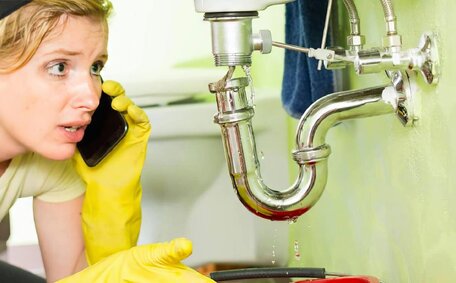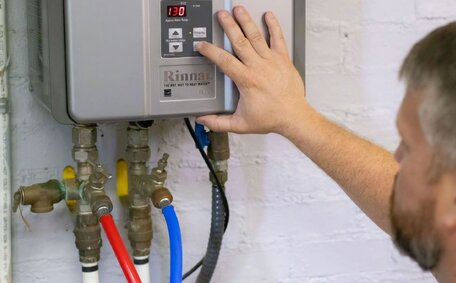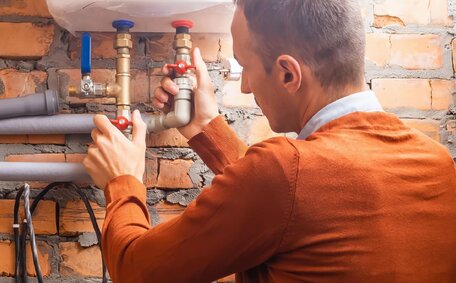Introduction: Key considerations when deciding hot water system location
Choosing the optimal location for your new hot water heater is critical for its performance and efficiency in your Ashfield property. The right placement, as per what your hot water system should have, can improve performance, efficiency, and safety. Proper positioning also guarantees compliance with building codes and regulations.
This guide explores the crucial factors for positioning your gas hot water system. We’ll provide recommendations for various water heating systems, such as solar, heat pump, gas, and electric models. Additionally, we’ll highlight critical safety precautions to consider during solar heat pump installation.
Enlisting a qualified Ashfield plumber, you’ll pinpoint the perfect installation setup for your hot water systems to meet your property’s specifications and usage patterns, and you might qualify for government rebates. Understanding these considerations is vital for the long-term effectiveness of your hot water system.
Performance and efficiency factors
Strategic location is essential to maximize your system’s heating efficiency and performance. Positioning hot water units near frequently used outlets like showers and sinks minimises heat loss in pipes. This delivers hot water quickly, cutting down on energy waste.
Selecting the appropriate size for your unit is crucial to achieve efficiency. A qualified Ashfield plumber will assess household size, water consumption, and bathroom count to choose a suitably sized hot water unit. An oversized or undersized unit will struggle to operate with energy efficient performance.
Installing hot water systems from top brands, particularly solar heat pumps, depends on adequate exposure to ambient heat for peak performance. Your plumber will recommend locations that ensure your solar system, equipped with the proper valves, gets sufficient sunlight or airflow.
Be cognizant of potential compliance issues, especially for homes in areas like the Northern Beaches – don’t place hot cold water units too close to boundaries or in the way of emergency access.
With strategic planning and professional guidance, you can resolve common hot water placement issues and achieve excellent efficiency for your new system when installing in Ashfield.
Proximity of system to hot water outlets
It is highly advisable to position your hot water system near taps, showers, and outlets to reduce heat loss in transit. The shorter distance to install hot water paths must travel through pipes, can reduce cooling and heat loss.
This quickens hot water delivery and curtails prolonged waits for warmth. Quick access means less new water wasted down the drain as you wait.
Placing the system near bathrooms, kitchens, and laundry rooms is ideal. Discuss layout and usage patterns with your Ashfield plumber to ensure the unit work is optimised in the most efficient position.
Reduced pipe lengths lead to more efficient water heating. Your hot water system doesn’t have to work as hard reheating cooled water over longer distances. This saves energy over time, making the system far more efficient whether it’s far away or nearby for hot water production.
Accounting for proper ventilation needs
Adequate ventilation, including an exhaust flue, is vital for any indoor gas system to ensure safe discharge of combustion gases. Poor ventilation puts you at risk of dangerous carbon monoxide buildup within the confines of your home.
Your qualified plumber will ensure that when installing new hot water heaters, including the tempering valve, they comply with all relevant standards, venting at least 50cm from any openings like windows or doors. Make sure there is adequate fresh airflow to supply the burner.
For indoor electric units or hot water heater inside models that are installed inside, ventilation enables condenser coils to dissipate heat effectively. Your plumber can recommend an appropriately cool, dry indoor location, factoring in all plumbing work and electrical considerations, away from other appliances producing warm air or moisture.
Ensuring proper ventilation around your water system installation is key to preventing overheating and maintaining family safety throughout the year. It also enables optimal performance so you reliably get hot water whenever you need it.
Safety protocols for system placement
Adhering strictly to safety protocols is a must when deciding on the location for your new water heater. Your trusted Ashfield plumber will ensure installation, including your old heater inside, complies with all relevant building codes and standards to maintain a hazard-free environment.
Indoor gas systems need correctly sized flues to draw combustion gases outside safely, keeping approved distances from windows and openings. Adequate ventilation must exist around the unit as well. Electric and solar hot connectors and wiring must be managed safely away from water sources and high traffic zones.
Outdoor systems should sit on weatherproof platforms that meet load requirements, with drip trays under tanks where necessary. Your plumber will advise on appropriate mounting, earthquake restraints, and drip trays if necessary based on climate exposure.
Easy access for future maintenance is essential. Ensure adequate room around the unit not only for repairs but also for the safety of technicians. Proper drainage below old hot water tanks helps avoid slips.
Adhering to safety standards during installation ensures reliable operation and protects your home and family from leaks or mishaps.
Clearances from walls, ceilings and flammable materials
When positioning your hot water system, it’s crucial to maintain proper clearances from walls, ceilings and flammable materials as stipulated by building codes. Indoor gas units installation location requires specific minimum clearances of at least 200mm from combustible surfaces and 500mm from other appliances.
These mandatory clearances, which your plumber will ensure, serve to reduce fire risks and allow for safe operation. They ensure combustion gases and heat dissipate safely without igniting building materials.
Outdoor units, especially those with a continuous flow feature, require sufficient clearance from structures and boundaries for safe operation. Your trusted Ashfield plumber will avoid having the system run too hot and expertly supply install necessities for your system, ensuring the unit can include earthquake restraints while meeting clearance requirements.
By observing the stipulated clearance gaps during installation for your water services, you ensure the location your hot water system is secure, protecting your property from damage and keeping technicians safe when servicing. This obedience also maintains optimal system functionality for energy-efficient hot water delivery.
Installing earthquake straps and brackets
Although Sydney has a lower earthquake risk, securing hot water systems with straps and brackets remains a prudent safety measure. Your Ashfield plumber can install these restraints to protect both property and people.
All outdoor units must have earthquake straps correctly affixed to a concrete base or wall. These durable straps prevent your electric hot water system with its storage tank from shifting violently during tremors, avoiding leaks or fires.
Indoor units must also be equipped with secured metal brackets, typically installed at the outset. Proactive earthquake-proofing reduces the chance of ruptured gas lines or water connections.
It’s affordable peace of mind knowing your hot water investment and household are better protected. Minor seismic activity can still destabilise unsupported systems. Your trusted plumber will ensure full compliance with earthquake restraint regulations in Ashfield and wider Sydney.
Connecting relief valves to safe drainage points
When installing a hot water system, it’s crucial to connect the pressure relief valve to a safe drainage point. This valve acts as a safety release, discharging water or steam if the system overheats or the pressure gets too high.
The drainage point should be in an area of your house that can safely handle hot water flow without causing property damage or injury risk, keeping installation cost in mind. An external wall, concrete floor, or grated drain are appropriate discharge points, directed away from areas like doorways or windows.
Routine checks and maintenance are crucial after having an installed new hot water system, ensuring its proper upkeep. Your trusted Ashfield plumber will ensure the valve is functioning correctly and is piped to suitable drainage during installation, for ongoing safety and satisfaction.
Avoiding flood zones and water damage
In planning your new hot water system installation in Ashfield, consider areas within your property that are susceptible to flooding. Situating heaters, tanks or pipes in a location prone to flooding can lead to extensive water damage over time.
To avoid costly flood damage, consult with your trusted Ashfield plumber who will consider what potential damage should be mitigated when deciding the best location to install the system your home needs. Factors like natural land contours, drainage patterns, history of flooding, and proximity to water lines should guide placement decisions.
Outdoor units with water storage tanks should be placed on elevated concrete bases to avoid flood-prone areas. Indoor water storage systems should be kept in well-drained areas of the home, with safe trays on drains as a safeguard. Condensate trays can also help divert leaks.
Taking the possibility of water damage into account when positioning your hot water system will extend the life your unit and give you greater peace of mind during heavy rains. Careful planning ensures uninterrupted performance and longevity of the unit over its lifetime.
Noise considerations for heat pump systems
When installing heat pump hot water systems, it’s important to account for potential noise from the outdoor unit. These systems operate by extracting ambient heat from outdoor air, which requires an external fan and compressor.
Compared to electric or gas systems, heat pump water systems’ noise levels can vary but generally run higher. The outdoor unit emits a dull hum or whooshing sound from the fan and compressor. This is especially noticeable at night when background noise is lower.
To minimise noise disturbance, place the outdoor unit away from bedrooms, living spaces, or property borders, and ensure connection to the main water supply is done by a fully qualified plumber. Your Ashfield plumber can recommend the optimal location to direct noise away from occupied sections of your property. They may also advise on noise reduction methods like sound barriers.
With strategic planning and your needs considered, the placement and noise mitigation of pump water heaters can provide energy-efficient hot water without disrupting your household, ensuring youll need less time adjusting for comfort. Discuss noise considerations with your installer upfront to maximise satisfaction.
Conclusion and next steps
Selecting the optimal site for your new hot water system entails critical considerations. By understanding key considerations around type hot efficiency, safety, noise, and compliance, you can identify the optimal location to meet your household’s needs.
Contact Ashfield Plumbing for assistance with selecting your water heating system, discovering rebate opportunities, installation, and advice on optimal placement. Leveraging over 50 years of experience, we are experts in Ashfield plumbing, adept at managing rebate options and installing systems attuned to your specific needs.
For personalised advice on maximising value, longevity and satisfaction from your type hot water system investment, call us on 1300 349 338, email [email protected] or book a consultaion. Our experts are eager to answer any inquiries regarding your property’s layout and water usage to suggest the most suitable system setup.






